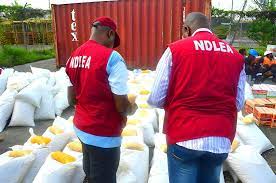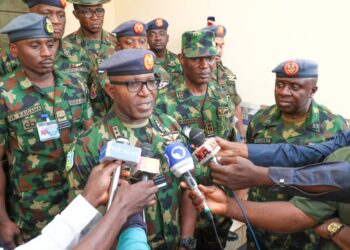The Chief of Army Staff (COAS), Lt. Gen. Tukur Buratai, was on operational visit to Camp Zairo, the former command and control centre of the Boko Haram terrorists, to confirm the recent recapture of the camp by troops. MUSA UMAR BOLOGI, who is in the frontlines reports.
The journey to Sambisa forest
The combat helicopter touched down at Bitta, a small settlement in the Sambisa forest, after about 50 minutes flight from Maiduguri.
Apart from troops and their arsenals, no other persons were seen in Bitta, which is now a ghost of its former self.
Boko Haram terrorists ransacked all settlements when they took over the Sambisa forest, after they were chanced out from the hinterland by troops in 2014.
At the initial take off, the helicopter maintain a high altitude, but came down so low about 20 minutes to landing in the Sambis forest. For journalists in entourage, this could mean a suicide mission. The thought was that the helicopter could be vulnerable to a terrorist target, which could be hiding on a tree. But this was not like a movie, the military have really dominated the general area of the forest, and the rea is secured from such an assault.
Looking down from the helicopter, one could see small erstwhile settlements destroyed by the terrorists, and several military locations in the forest. And like other locations in the forest, troops are stationed in Bitta as part of efforts to dominate the general area and stop the terrorists from regrouping.
Sambisa forest is about 60 km. south east of Maiduguri, Borno State. It occupies parts of the states of Borno, Yobe, Gombe, Bauchi along the corridor Darazo, Jigawa, and some parts of Kano state farther north. It is administered by Askira/Uba in the south; Damboa in the southwest; and by Konduga and Jere in the west.
The name of the forest comes from the village of Sambisa which is on the border with Gwoza in the East.
The Sambisa forest has sparse vegetation is the norm. Most of the vegetation is typical of the Sudan Savanna although, because of human activity, some parts have become more like the Sahel savanna. The forest consists of a mixture of open woodland and sections of very dense vegetation of short trees and thorny bushes.
Moving towards Camp Zairo
The troops first captured Camp Zairo, the command and control centre of the Boko Haram terrorists in the Sambisa forest in December 2016. However, the terrorists later regrouped in the forest and began to launch pockets of attacks.
In January 2018, the military recaptured the Camp Zairo and sacked the factional leader of the Boko Haram terrorists, Abubakar Shekau, who is now on the run, disguising in woman attire, according to the military.
Shekau, in a video he later released, disclosed he had suffered heavy casualty during the military raid and said he preferred to die than being captured. His statement gave credence to the military’s claim that the terrorists had been greatly decimated and defeated.
The Nigerian Army has promised three million naira reward for anybody that provides useful information that could lead to the arrest of the terrorists’ leader.
The Sambisa forest is a difficult terrain both in the wet (May and September/October) and dry (November to May) seasons. In the wet season the terrain is usually swampy and water lodged. While in the dry season it is sandy and dusty. Troops and movement of equipment is very difficult during the wet season.
Moving from one location to the other in the forest was a tedious task because of its sandy nature. Hilux vehicles could not perform this duty. An Mrap – an ambush and mines resistant vehicle- was used to move the COAS and his team from one location to the other.
Ventilation in the M-rap was not too good, and the only window that could be opened for fresh air to come in had to be partially opened to prevent dust from coming into to vehicle.
From Bitta, it took about 25 minutes to get to Tokumbere, another erstwhile settlement in the forest. At Tokunbere troops were stationed with equipment to maintain dominance of the area. The army chief and his entourage spent quite sometime in the location, as they were conducted round the location. He also interacted with troops, trying to understand the challenges they face and how to quickly address them.
The Camp Zairo
Moving slowly, the M-rap struggled through the sand and we arrived Camp Zairo at about 4:15pm. Camp Zairo was originally called “Sabil Hida”, meaning the “righteous place”, but the name was changed by the terrorists to fit their evil interest.
At Came Zairo, the army chief was conducted round the Battle Groups 1 and 2 deployments locations, the new borehole and shown some of captured Boko Haram terrorists Armoured Fighting vehicles and equipment.
In his address to troops the COAS charged them to capture the factional leader of Boko Haram, Abubakar Shekau “red handed” and hand over to him.
“We must move across wherever this criminal is to catch him red handed. I want you to get him by hand,” he said.
“On behalf of Mr. President I say congratulations to all of you for clearing this Sambisa forest. As far as we are concern we have come to the end of this operation. What is remaining now is the Lake Chad waters. And we hope to do that also very soon.
“Meanwhile, we all know these criminals are still on the run. We must make sure we get they were ever they are in around this area. We must not allow them to escape. That means every day you must go on patrols, lay ambush for them and go on raids. This is the time we have to consolidate and ensure that this place is safe; and never for these criminals to come back to this forest.
“The Federal government is doing a lot, as we are expecting more equipment to be procured for our operations. You are very much aware of the National Economic Council support for us to procure equipment for our operations already we have made all our requirements and it is being considered.
“Also you welfare is very important to us. We will make sure that you get all your entitlements, and also ensure regular rotations are carried out. Plans are on for those that have stayed here for long to be rotated. This is in our plans and we must do it.”
The said the army would transform the Sambisa forest, apart from being its training area (Nigerian Army Small Championship was staged in the forest in March 2017), to a broad defence establishment “in terms of the provision of basic requirement for the comfort of troops in order to be more effective in their operation.”
“We are already working hard to make sure that the first set of facilities is brought here. Be rest assured all you challenges; all you requirements will be taken care off.
“We are going to have some special packages for those of you that have penetrated this forest and did Mr. President proud,” Buratai said.
The army chief also addressed and interacted with the elements of Cameroonian Defence Forces in the area.
Buratai acknowledged the efforts of other services and the security agencies in the capture of the Sambisa forest and fight against Boko Haram terrorists.
The Theater Commander, Operation Lafiya Dole, Maj. Gen. Rogers Nicholas during an interview at the Sambisa forest that his major task by the army chief after his (Nicholas’s)appointment was to recapture Camp Zairo and ensure total dislodgement of the terrorists from the Sambisa forest.
“Today our presence here is to further confirm that the Nigerian Armed Forces has completely destroyed Boko Harm in Sambisa forest, and we are presently occupying Camp Zairo and other small camps in the Sambisa forest,” he said. “This is to show that the heart and mind of Boko Haram has been broken in the Sambisa forest.”
“We are still going round the forest for some of them that are hiding in the holes here and there and fish them out. The visit of the Chief of Army Staff here today is to see and further confirm that Boko Haram has been completely defeated in Sambisa forest.”
Visits to Gubi, Bama, Dikwa
While the Chief of Army Staff and his team were at Sambisa Forest, the Chief of Training and Operations, Maj. Gen. David Ahmadu, Director Military Intelligence, Maj. Gen. AA Tarfa and Provost Marshal, Maj. Gen. AT Hamman led other teams to 5 Brigade, 21 and 22 Brigades Nigerian Army at Gubio, Bama and Dikwa, respectively.
Their visits, according to the army spokesperson, Brig. Gen. Sani Usman, followed the same pattern with that of the Chief of Army Staff.
“They received briefing, went round troops deployments, addressed and interacted with the troops,” he said. “They were equally accompanied by other senior officers from the Army Headquarters and the Theatre Command.”



